Samsung vs. Fujitsu: Mini Split Features & Technology Compared

When it comes to keeping your home comfortable year-round, the choice of heating and cooling systems can feel overwhelming. Have you ever wondered if a mini-split system might be the right fit for you? These compact systems are increasingly popular among homeowners because they offer flexibility and impressive energy efficiency. In this article, we’ll dive into two top brands in the mini-split market: Samsung and Fujitsu. We’ll compare their features, technology, and what sets them apart, helping you make a smarter decision suited to your needs. Whether you’re battling hot summers or chilly winters, understanding these options can guide you toward finding the perfect solution for your home environment.
The key differences between Samsung and Fujitsu mini-split systems include Samsung’s slightly higher heating output at lower temperatures, making it more energy-efficient during colder months, while Fujitsu lacks cold climate versions suitable for harsh winters. Additionally, Samsung units are often praised for their durability, whereas Fujitsu models have reported issues with circuit board failures in specific regions, impacting overall reliability.
Overview of Samsung and Fujitsu Mini Split Systems
Mini-split systems are increasingly becoming the go-to choice for homeowners seeking efficient heating and cooling solutions without the bulk of traditional HVAC systems. Among the top brands in this arena, Samsung and Fujitsu stand out with their innovative technologies and tailored offerings. While both brands excel in providing comfort, they approach efficiency and performance somewhat differently, which can influence your decision based on your specific needs.
Samsung Mini Split Systems
Samsung mini splits are often lauded for their robust construction and cutting-edge technology. One of their notable strengths lies in their higher-end components, which include advanced inverter technology that allows the systems to adjust their output according to real-time conditions. This means that a Samsung system can maintain comfortable temperatures while being mindful of energy consumption.
In regions experiencing colder winters, you’ll find that Samsung units may slightly outperform others due to their ability to deliver higher heating outputs at lower temperatures. This capability not only provides consistent warmth but also translates into potential savings on energy bills during cold months. Furthermore, many Samsung models integrate with SmartThings, empowering users to control their home environment remotely through mobile devices.
Fujitsu Mini Split Systems
On the flip side, Fujitsu mini splits have carved out a niche in delivering reliable performance with an unwavering focus on energy efficiency. This brand is particularly recognized for offering models crafted to suit various environmental conditions, which enables them to function effectively even in harsh climates.
While some Fujitsu models may lack options specifically optimized for extreme cold, they are still engineered to perform admirably under typical conditions encountered by average households. Users appreciate that Fujitsu units run quietly, contributing to a serene indoor environment—an essential quality for living spaces or bedrooms where noise sensitivity is crucial.
With these foundational differences outlined, it’s important to consider how each brand’s distinct approach influences their effectiveness and overall functionality, especially concerning your local climate conditions.
Efficiency and Performance
When it comes to ductless mini-split systems, energy efficiency can deeply impact your wallet. According to the U.S. Department of Energy, these systems can cut heating costs by as much as 40% when compared to traditional HVAC systems, making them an attractive choice for budget-conscious homeowners.
EER and SEER Ratings
A key metric to consider is the EER (Energy Efficiency Ratio) and SEER (Seasonal Energy Efficiency Ratio) ratings that manufacturers provide.
Samsung units tend to shine here, often boasting impressive EER and SEER ratings that usually exceed 20. This high efficiency translates into significant savings on utility bills over time. For example, the Samsung Wind-Free Elite model offers a remarkable SEER rating of 25.5, which means you get more cooling for less energy consumption—much more money left in your pocket!
On the other hand, Fujitsu does not fall short either. Their models, like the Fujitsu Halcyon, can achieve a commendable SEER of 22. However, what sets Fujitsu apart is its performance in colder climates. With advanced technology designed specifically for low-temperature operation, these units maintain high efficiency even when the weather is harsh.
Performance in Different Conditions
It’s worth mentioning that while Samsung excels in moderate climates, Fujitsu systems are better equipped to handle low temperatures without sacrificing performance. This can be crucial if you live in areas where winters get particularly icy and chilly, as Fujitsu units consistently deliver reliable heating capabilities even in frigid conditions.
With energy efficiency thoroughly examined, it’s time to explore how these brands compare regarding their capacities for both indoor and outdoor installations.
Indoor and Outdoor Capacities
Both Samsung and Fujitsu mini-split systems are designed with user comfort in mind, offering a range of options to meet various heating and cooling needs. When it comes to indoor units, Samsung models symbolize modern elegance and efficiency, boasting sleek designs such as the Wind-Free 2.0. This innovative model uses micro-holes that allow for gentle air distribution, avoiding the uncomfortable blast of air you might experience with traditional systems. The capacity for Samsung’s indoor units typically ranges from 9,000 to 36,000 BTU, striking a balance between power and space efficiency.
On the other hand, Fujitsu takes versatility to another level with its selection of indoor options, which includes wall-mounted, ceiling-mounted, and even floor console units. This flexible design allows Fujitsu’s devices to cater not only to aesthetic preferences but also adapt to various room shapes and sizes, providing an extensive capacity range from 9,000 up to 60,000 BTU. Such variety ensures its suitability for larger spaces or homes needing more robust heating and cooling solutions.
Moving outside, let’s explore the capabilities of their respective outdoor units.
When we turn our attention to the outdoor units, Samsung shines with its compact yet efficient designs. Take the Samsung FJM (Free Joint Multi), for example; this model can support up to five indoor units simultaneously while maintaining performance integrity. Not only does this reduce the number of outdoor components needed for multi-zone heating or cooling, but it also enhances energy efficiency by minimizing operational redundancies.
Conversely, Fujitsu emerges as a strong competitor through the engineering of its outdoor units. Like Samsung’s offerings, these systems can support multiple indoor units. However, what sets Fujitsu apart is its ability to function optimally in extreme climate conditions, especially for regions that experience very cold winters or transitioning weather patterns where consistent efficiency becomes paramount.
With a firm grasp on these capabilities, we can now shift our focus towards exploring some advanced features that enhance user experience even further.
Cost
The initial investment in a mini-split system often influences consumer choices significantly.
When discussing cost, depending on factors such as capacity and specific features, the price point reflects the robust technology and effective performance that come with their systems.
Searching for budget-friendly options? Both brands’ pricing structures offer competitiveness but vary slightly based on model and performance specifications.
Initial Cost
While costs are comparable, investing in a more expensive unit doesn’t always equate to better performance. If you’re considering how best to spend your dollars, think about both the purchase price and the expected long-term expenses.
For example, higher-priced models often come equipped with advanced energy-saving technologies, which can lead to lower electricity bills over time.
Considering both models can lead to significant savings in the long run:
- Samsung units: Popular for their affordability while providing strong features.
- Fujitsu offers highly energy-efficient units that may have a higher initial cost but yield substantial energy savings down the line.
Ultimately, evaluating these aspects will provide clarity in selecting the right mini-split system that aligns with your unique requirements. Each brand has its strengths; however, they both deliver dependable mini-split systems.
Therefore, assessing your specific needs—including climate demand, room size, and desired smart features—will guide you to make the most informed choice possible. For personalized recommendations or inquiries about installation, visit Diamond Comfort or call us at (413) 527-4737.
Have Any Questions?
Get in contact with us today! We are always happy to help, and you can count on our expertise.

